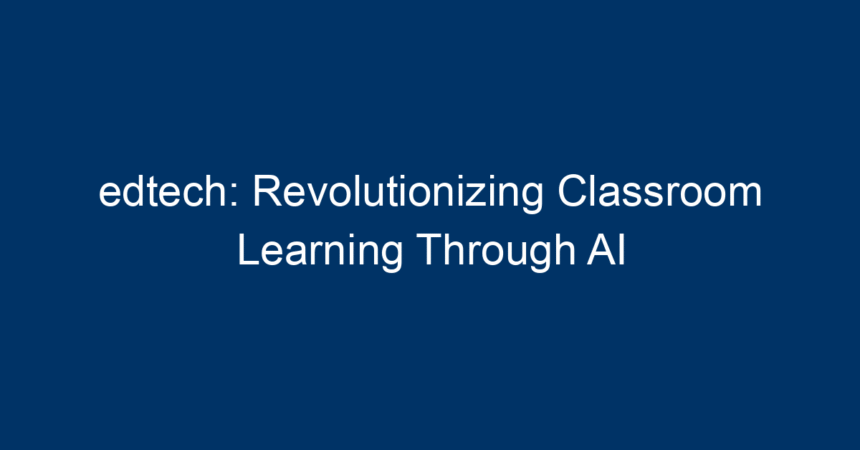Introduction
The educational landscape is shifting dramatically, and at the forefront of this transformation is edtech—the integration of technology into education. With the advent of Artificial Intelligence (AI), classrooms are becoming more interactive, personalized, and efficient than ever before. This article explores how edtech is revolutionizing learning environments, enhancing student engagement, and providing tailored educational experiences.
What is EdTech?
Edtech refers to the use of technology and software to enhance learning experiences, streamline administrative processes, and improve educational outcomes. From digital classrooms and online learning platforms to AI-driven tools and applications, edtech encompasses a broad spectrum of innovations that are reshaping the way students and educators interact.
The Role of AI in EdTech
At the core of edtech innovations is AI, which uses algorithms to analyze data, automate repetitive tasks, and enhance decision-making. In education, AI can assess a student’s learning style, adapt resources to meet their needs, and even predict future outcomes based on current performance.
Traditional vs. AI-Driven Learning Environments
Traditional classrooms often follow a one-size-fits-all approach, where teachers deliver standardized content to a diverse group of students. However, this method can leave many behind, as it fails to address individual learning preferences.
AI-driven learning, on the other hand, allows for personalized educational experiences. AI can analyze a student’s strengths and weaknesses, making it possible to customize studies to fit each learner’s unique needs.
Transformative Applications of EdTech and AI
1. Personalized Learning Experiences
The most significant advancement in edtech through AI is personalized learning. AI platforms can identify individual student needs by analyzing learning patterns, quiz results, and engagement levels.
For example, platforms like Knewton and DreamBox use AI algorithms to offer customized content, enabling students to learn at their own pace. This adaptability not only boosts understanding but also enhances retention, making learning more effective overall.
2. Intelligent Tutoring Systems
Intelligent Tutoring Systems (ITS) are another groundbreaking application of AI in edtech. These systems provide instant feedback and adaptive assistance, simulating the experience of having a personal tutor.
Examples include Carnegie Learning, which focuses on mathematics, and Duolingo, which facilitates language learning. With ITS, students receive tailored instruction and support that aligns perfectly with their learning journey.
3. Enhanced Administrative Efficiency
AI in edtech also streamlines administrative processes, freeing up educators to focus on teaching. Tools such as grading software automate the evaluation of student work, while data analytics can inform decisions about curricula and resource allocation.
Systems like Canvas and Blackboard offer comprehensive learning management solutions that track student performance, ensuring that educators have the insights they need to make informed decisions.
4. Engagement and Gamification
Incorporating AI into gaming elements fosters increased student engagement. Educational games powered by AI adapt to player skill levels, making learning fun while promoting critical thinking and problem-solving skills.
Platforms like Kahoot! and Quizlet provide interactive quizzing experiences, turning assessment into a competitive game that motivates students to learn rather than dread it.
5. Virtual and Augmented Reality
Virtual reality (VR) and augmented reality (AR) are also making waves in the world of edtech. These technologies immerse students in rich learning environments that enhance their understanding of complex subjects.
For instance, Google Expeditions allows students to explore everything from historical sites to the human body. By utilizing AI, these platforms can adjust levels of difficulty or content focus based on real-time student feedback, ensuring a tailored experiential learning experience.
The Future of EdTech and AI
As technology continues to advance, the potential for edtech and AI in education is limitless. Predictive analytics, natural language processing, and machine learning will further refine the personalization of learning, making educational content accessible anytime, anywhere.
Challenges of Integrating AI in Education
Despite the benefits, there are challenges to integrating AI solutions in the classroom. Concerns about data privacy, equity in access, and the potential for over-reliance on technology are valid. Educators and policymakers must work together to ensure that AI serves as an enhancement, not a replacement, for human interaction.
Actionable Insights for Educators and Institutions
1. Embrace AI-Driven Tools
Educators should explore AI-driven platforms and applications to offer tailored learning experiences. Tools like Quizlet, Knewton, and Carnegie Learning can personalize content and provide support that enriches student engagement and comprehension.
2. Invest in Professional Development
Training and support are crucial for teachers to adapt to new technology. Institutions should invest in ongoing professional development focused on effectively using AI and other edtech tools.
3. Encourage Experimentation and Feedback
Educators should experiment with different edtech resources, gathering feedback from students to understand what works. Continuous feedback will guide improvements and foster a more inclusive learning environment.
4. Prioritize Data Privacy
As technology becomes more integrated into education, it is vital to prioritize data privacy. Establish policies that protect student data while leveraging analytics to improve learning outcomes.
5. Foster a Culture of Innovation
By encouraging innovation and creativity among educators, we can continue to explore new ways to integrate AI in classrooms. Create environments that celebrate experimentation and recognize successful initiatives that enhance learning experiences.
Conclusion
In conclusion, edtech is revolutionizing classroom learning through the integration of AI, paving the way for personalized, efficient, and engaging educational experiences. By embracing these technologies, educators can unlock new opportunities for their students while ensuring that learning remains a deeply human experience. The future of education lies in the intersection of technology and pedagogy, and those who adapt will undoubtedly excel.
Incorporating AI within the edtech space is not just a trend; it is the future of learning. By understanding and implementing these innovations, we can transform classrooms into dynamic environments where all students have the opportunity to succeed.




